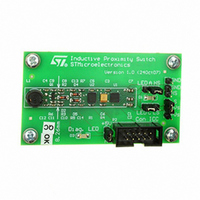STEVAL-IFS006V1 STMicroelectronics, STEVAL-IFS006V1 Datasheet - Page 29

STEVAL-IFS006V1
Manufacturer Part Number
STEVAL-IFS006V1
Description
BOARD EVAL 8BIT MICRO + TDE1708
Manufacturer
STMicroelectronics
Datasheets
1.TDE1708DFT.pdf
(14 pages)
2.STEVAL-IFS006V1.pdf
(136 pages)
3.STEVAL-IFS006V1.pdf
(4 pages)
Specifications of STEVAL-IFS006V1
Design Resources
STEVAL-IFS006V1 Bill of Material
Sensor Type
Proximity
Interface
I²C
Voltage - Supply
6 V ~ 48 V
Embedded
Yes, MCU, 8-Bit
Utilized Ic / Part
ST7FLITEUS5, TDE1708
Processor To Be Evaluated
ST7LITEUS5
Data Bus Width
8 bit
Operating Supply Voltage
6 V to 48 V
Silicon Manufacturer
ST Micro
Silicon Core Number
TDE1708DFT
Kit Application Type
Sensing - Touch / Proximity
Application Sub Type
Proximity Switch
Kit Contents
Board
Rohs Compliant
Yes
Lead Free Status / RoHS Status
Lead free / RoHS Compliant
Sensitivity
-
Sensing Range
-
Lead Free Status / Rohs Status
Lead free / RoHS Compliant
Other names
497-6403
STEVAL-IFS006V1
STEVAL-IFS006V1
Available stocks
Company
Part Number
Manufacturer
Quantity
Price
ST7LITEUS2, ST7LITEUS5
Note:
Caution:
Note:
1
2
3
1
2
3
In I
selection in the option byte. Refer to note 5 in
See
accuracy of the RC oscillator.
To improve clock stability and frequency accuracy, it is recommended to place a decoupling
capacitor, typically 100nF, between the V
device.
If the voltage or temperature conditions change in the application, the frequency may need
to be recalibrated.
Refer to application note AN2326 for information on how to calibrate the RC frequency using
an external reference signal.
The ST7LITEUS2 and ST7LITEUS5 also contain an Auto-wakeup RC oscillator. This RC
oscillator should be enabled to enter Auto-wakeup from Halt mode.
The Auto-wakeup RC oscillator can also be configured as the startup clock through the
CKSEL[1:0] option bits (see
This is recommended for applications where very low power consumption is required.
Switching from one startup clock to another can be done in run mode as follows (see
Figure
Case 1
Switching from internal RC to AWU:
1.
2.
3.
4.
5.
Case 2
Switching from AWU RC to internal RC:
1.
2.
3.
4.
5.
When the internal RC is not selected, it is stopped so as to save power consumption.
When the internal RC is selected, the AWU RC is turned on by hardware when entering
Auto-wakeup from Halt mode.
When the external clock is selected, the AWU RC oscillator is always on.
2
C mode, the internal RC oscillator is forced as a clock source, regardless of the
Section 12: Electrical characteristics
Set the RC/AWU bit in the CKCNTCSR register to enable the AWU RC oscillator
The RC_FLAG is cleared and the clock output is at 1.
Wait 3 AWU RC cycles till the AWU_FLAG is set
The switch to the AWU clock is made at the positive edge of the AWU clock signal
Once the switch is made, the internal RC is stopped
Reset the RC/AWU bit to enable the internal RC oscillator
Using a 4-bit counter, wait until 8 internal RC cycles have elapsed. The counter is
running on internal RC clock.
Wait till the AWU_FLAG is cleared (1AWU RC cycle) and the RC_FLAG is set (2 RC
cycles)
The switch to the internal RC clock is made at the positive edge of the internal RC clock
signal
Once the switch is made, the AWU RC is stopped
9):
Section 14.1 on page
DD
for more information on the frequency and
and V
Section 4.4 on page 19
SS
123).
Supply, reset and clock management
pins as close as possible to the ST7
for further details.
29/136





















